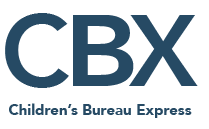October 2023Vol. 24, No. 8Creating an Affirming Culture and Climate for LGBTQIA2S+ Children, Young People, and Families in Child Welfare
Written by the Capacity Building Center for States
Children and young people who identify as lesbian, gay, bisexual, transgender and/or gender expansive, queer and/or questioning, intersex, asexual, and two-spirit (LGBTQIA2S+) are disproportionately represented in the child welfare system, where they may encounter challenges ranging from discrimination and unequal access to appropriate services to homelessness and more (National Association of Social Workers, n.d.; Trevor Project, 2021; U.S. Government Accountability Office, 2022). Research consistently shows that these young people experience higher rates of mental health concerns, substance use, homelessness, and suicidality compared to their heterosexual and cisgender peers (National Alliance on Mental Health, n.d.). This is even more true for those LGBTQIA2S+ children and young people with additional marginalized identities such as non-White race, non-European ethnicity, or immigrant status. For example, American Indian/Alaska Native (AI/AN) LGBTQIA2S+ young people were 2.5 times more likely to report a suicide attempt in the past year (33 percent) compared to non-American Indian/Alaska Native LGBTQIA2S+ young people (14 percent) (Zongrone, et al., 2020).
The struggles and challenges faced by LGBTQIA2S+ children and young people in child welfare demand our urgent attention. By acknowledging the disparities they face and working to address them, we can take meaningful steps toward creating a child welfare system that is truly inclusive, supportive, and respectful of the diverse identities within its care.
Establish Unambiguous Policies Prohibiting Discriminatory Actions Against LGBTQIA2S+ People
Despite the existence of federal laws that address the safety and well-being of children and young people in foster care, including those with LGBTQIA2S+ identities, anti-LGBTQIA2S+ legislation continues to be introduced. For example, in 2023 so far, 80 anti-transgender bills have been passed by legislatures in 22 states, and more are pending.
ACF Information Memorandum 22-01 states that public child welfare agencies must address the needs of children and young people in their care, including needs related to sexual orientation and gender identity expression (SOGIE). To that end, child welfare agencies must establish clear, unambiguous policies that explicitly prohibit discrimination based on SOGIE. These policies should also outline the steps to be taken if such discrimination occurs. Additional policy-related actions agencies can take include the following:
- Creating or amending a foster care bill of rights that specifies rights related to LGBTQIA2S+ identity
- Hiring a dedicated staff member responsible for policy, best practices, and guidance for serving LGBTQIA2S+ children, young people, and families engaged with the agency
- Collecting data related to SOGIE to understand whether the agency is properly serving LGBTQIA2S+ children and young people
- Establishing consistent practice around asking for and using correct pronouns and chosen names in all conversations and documentation
Institute Regular Cultural Competency Training
Many child welfare professionals lack the training and cultural competency to understand the unique needs of LGBTQIA2S+ young people, which can hinder the provision of appropriate services and care. All child welfare professionals and their partners should attend trainings that enhance their understanding of issues unique to SOGIE and LGBTQIA2S+ young people (including Latinx and Black LGBTQIA2S+ young people) and offer practical strategies they can apply in their work. Such issues may include access to affirming care, the importance of using correct pronouns and chosen names, and creating inclusive environments. Tribal and jurisdictional agencies should also take steps to educate staff about Two-Spirit and other AI/AN nondominant SOGIE identities to better serve LGBTQIA2S+ AI/AN children and young people in care.
Child welfare agencies should partner with LGBTQIA2S+ organizations to develop training materials, resources, and support networks. These collaborations can offer expertise and insights that contribute to a more informed and empathetic approach toward LGBTQIA2S+ children, young people, and families.
Make Your Agency a Safe Space for LGBTQIA2S+ Children, Young People, and Families
Creating safe spaces for LGBTQIA2S+ children, young people, and families within the child welfare system is essential, and it is important that the agency be one of them. Some actions the agency can take include hanging “All Are Welcome” signs and rainbow flags in social services buildings, updating all forms with inclusive language, and adding SOGIE-related language to posted nondiscrimination policies and promotional and information materials. In addition, offering support groups, counseling services, and resources that affirm LGBTQIA2S+ identities can play a pivotal role in fostering a sense of belonging and reducing the mental health challenges faced by LGBTQIA2S+ children and young people.
As you consider the information, data, and resources below, take time to think about the ways you and your agency are currently creating safe spaces for LGBTQIA2S+ individuals and the actions you can take to affirm and support LGBTQIA2S+ children, young people, and families.
Resources
The following Center for States resources can help agencies create an affirming culture and climate for LGBTQIA2S+ young people and families.
- Becoming a Family-Focused System (resource series)
- Change and Implementation in Practice: Teaming (resource collection)
- Creating LGBTQ Affirming Agencies (video and discussion guide)
- Toolkit to Support Child Welfare Agencies in Serving LGBTQ Children, Youth, and Families (resource collection)
Additional resources include:
- Collecting Data on Sexual Orientation, Gender Identity, and Expression (podcast series) (Administration for Children and Families)
- Guidance for the Placement of Transgender, Non-Binary, and Gender Expansive Youth in Congregate Care (publication) (Human Rights Campaign)
- Erasure and Resilience: The Experiences of LGBTQ Students of Color: Latinx LGBTQ Students in U.S. Schools (publication) (GLSEN)
- Implementing System Wide Policy and Practice Improvements to Support LGBTQ+ Youth and Families With Child Welfare System Involvement (publication) (Center for the Study of Social Policy and the University of Houston Graduate College of Social Work)
- Indigenizing Love: A Toolkit for Native Youth to Build Inclusion (publication) (Western States Center)
- The National Center for Young People With Diverse Sexual Orientation, Gender Identity, & Expression (organization)
- Organizations Serving the Black LGBTQ+ Community (online resource list) (It Gets Better Project)
- Umbrella Summary: Psychological Safety (Quality Improvement Center for Workforce Development)
References
National Alliance on Mental Health. (n.d.). LGBTQ+. https://www.nami.org/Your-Journey/Identity-and-Cultural-Dimensions/LGBTQ
National Association of Social Workers. (n.d.). LGBTQIA2S+. https://www.socialworkers.org/Practice/LGBTQIA2S
Trevor Project. (2021). National survey on LGBTQ youth mental health 2021. https://www.thetrevorproject.org/survey-2021/
U.S. Government Accountability Office. (2022). Report to the chairman of the Subcommittee on Worker and Family Support, Committee on Ways and Means, House of Representatives: Foster care: Further assistance from HHS would be helpful in supporting youth's LGBTQ+ identities and religious beliefs (GAO-22-104688). https://www.gao.gov/assets/gao-22-104688.pdf
Zongrone, A. D., Truong, N. L., & Kosciw, J. G. (2020). Erasure and resilience: The experiences of LGBTQ students of color: Native American, American Indian, and Alaska Native LGBTQ youth in U.S. schools. Gay, Lesbian, and Straight Education Network. https://www.glsen.org/sites/default/files/2020-03/Erasure-and-Resilience-Native-2020.pdf




